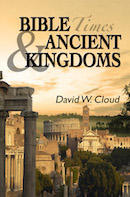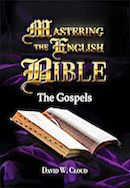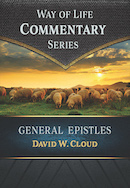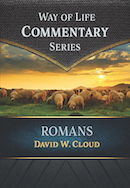866-295-4143, fbns@wayoflife.org
Another example of how the Roman Catholic Church is spreading her tent to encompass pagan religions in these last days is the life of Benedictine monk ALAN RICHARD “BEDE” GRIFFITHS (1906-93), who called himself Swami Dayananda (bliss of compassion).
Griffiths was born in England to an evangelical Anglican family. His father “had a simple, evangelical religion, and a devotion to Moody and Sankey’s hymns, which he was never tired of singing” (Griffiths, The Golden String, p. 18).
The steps that led Griffiths from this evangelical faith to Hinduism began with his education. The Bible warns that “evil communications corrupt good manners” (1 Corinthians 15:33). Griffiths was first influenced by a “Christian humanist” named W.H. Fyfe at Christ’s Hospital grammar school. Fyfe “did not believe in dogma” and claimed that the virgin birth of Christ doesn’t matter (p. 23). Next Griffiths went to Magdalen College at Oxford University, where “the prevailing thought was skeptical.” He said, “... most of my friends who read philosophy soon came to the conclusion that truth was something which it was impossible to know” (p. 31).
Another major step toward unbelief was Griffiths’ private reading. He says, “For by this time I had begun to read for myself, and my reading was to draw me gradually away from the Church, and eventually from any recognised form of religious belief. ... In this way though I scarcely realised it my reading was leading me to a view of life which was essentially pagan rather than Christian” (pp. 21, 25). He was greatly influenced by the Unitarians such as Samuel Coleridge and William Wordsworth. Coleridge was a leader of the “broad church” movement that was leading the Church of England in a liberal direction. Wordsworth was a worshiper of nature. Griffiths says, “The love of nature was the only thing which then moved me deeply, and I found in Wordsworth a religion which was wholly based on this” (p. 33). He was particularly attracted to Wordworth’s mysticism, which was a “kind of trance which he experienced in the presence of nature” and a “state of ecstasy ... an experience which gave one a direct insight into the inner meaning of life” (p. 34).
Griffiths was also influenced by the psychological theories of Carl Jung.
Griffiths called creation, the fall, the virgin birth, resurrection, ascension, heaven, and hell “the language of mythology” (The Marriage of East and West, pp. 28, 34, 175, 176, 187). He said that the resurrection of Christ was “not an event in space and time” (The New Creation in Christ: Christian Meditation and Community, p. 77).
As for the doctrine of hell, Griffiths said, “But at least, we can dismiss from our minds all thought of an endless suffering in time” (The Marriage of East and West, p. 35).
He called the doctrine of man’s separation from God “an illusion” (p. 55).
Griffiths had rejected Jesus Christ and the Bible and was pursuing the impossible dream of finding ultimate truth elsewhere. He was treading a frightful path of spiritual blindness. “In whom the god of this world hath blinded the minds of them which believe not, lest the light of the glorious gospel of Christ, who is the image of God, should shine unto them” (2 Corinthians 4:4).
In 1931, while at Oxford, Griffiths converted from Anglicanism to Catholicism. In this he was influenced by the writings of John Newman, one of the fathers of the Oxford Movement. Newman left the Chuch of England and joined the Catholic Church (eventually becoming a Cardinal), and multitudes followed in his footsteps. Through Newman Griffiths was introduced to the “church fathers,” who taught him the heresies that “the Church was infallible” and that the authority of the apostles has come to reside in the Catholic bishops, with the “Bishop of Rome” as the successor of Peter.
Griffiths also studied the writings of Catholic mystics such as Benedict, Thomas Kempis (The Imitation of Christ), William Law, Jacob Boehme, Johann Tauler, Henry Suso, Ignatius Loyola, and John of the Cross. Griffiths lived alone in a hermitage and practiced Catholic asceticism.
He came to believe that through meditation one can find God “beyond all thought and feeling and imagination” (The Golden String, p. 116) and “beyond images and concepts, beyond reason and will” (The Marriage of East and West, p. 22). In fact, this is blind mysticism. It is to reject the God of biblical revelation for an idol, but Griffiths said, “I wanted to abandon myself utterly to this power” (p. 111), ignoring the Bible’s warning that “Satan himself is transformed into an angel of light” (2 Cor. 11:14).
In 1932, Griffiths joined the Benedictine monastery of Prinknash Abbey near Gloucester and was ordained a priest eight years later. The name Bede was given to him when he entered the Benedictine order. It means prayer.
In 1955, he went to India at the invitation of an Indian Benedictine monk to help found a Benedictine monastery. He wrote to a friend saying, “I want to discover the other half of my soul” (Griffiths, The Marriage of East and West, p. 3). In 1958, he settled at Kurisumala Ashram in Kerala, at first living in a palm leaf hut. He adopted the lifestyle of a Hindu jogi, wearing the saffron-colored kavi, going barefoot, meditating, eating no meat. They read from the Hindu scriptures in the morning, from the Muslim Koran and the Sikh scriptures at midday, and from Indian poets and mystics at night (p. 20). His objective was to “find the way to the marriage of East and West” (p. 4). He says, “Thus we began to realize that truth is one, but that it has many faces, and each religion is, as it were, a face of the one Truth, which manifests itself under different signs and symbols in the different historical traditions” (The Marriage of East and West, p. 20).
Several years after settling in Kerala Griffiths moved to the Shantivanam Ashram, invited there by Henri le Saux, when he moved to the Himalayas.
Through his books and lectures, Griffiths has had a large role in promoting the interfaith philosophy in Roman Catholic monasteries in America, Canada, England, Australia, and Germany. He wrote 12 books on interfaith dialogue, the most popular being The Marriage of East and West.
Griffiths was deeply affected by his interfaith associations. He adopted the heresy of universalism.
“Christ died for all from the beginning to the end of time, to bring all people to that state of communion with God, with the eternal Truth and Reality, for which they were created. ... Wherever man encounters God, or Truth, or Reality, or Love, or whatever name we give to the transcendent mystery of existence, even if he is formally an atheist or an agnostic, he encounters the grace of God in Christ” (The Marriage of East and West, pp. 33, 34).
“... every Church, every religion, every human community, is only a stopping place, a tent which is pitched on this earth by pilgrims who are on their way to the City of God” (The Marriage of East and West, p. 39).
Griffiths believed that all men who follow their own reason are disciples of Christ:
“All men, therefore, who are guided by their reason and conscience and follow the light which has been given them, are truly by their implicit faith and desire disciples of Christ and vitally related to his Church” (The Golden String, p. 176).
Griffiths accepted the Hindu concepts of dualism and the interrelatedness of everything (monism). At a talk he gave in 1991 Griffiths said:
“I saw God in the earth, in trees, in mountains. It led me to the conviction that there is no absolute good or evil in this world. We have to let go of all concepts which divide the world into good and evil, right and wrong, and begin to see the complimentarity of opposites which Cardinal Nicholas of Cusa called the coincidentia oppositorum, the ‘coincidence of opposites’” (http://www.bedegriffiths.com/bio.htm).
Griffiths promoted a New Age integration of Christianity with evolution and eastern religion.
“We’re now being challenged to create a theology which would use the findings of modern science and eastern mysticism which, as you know, coincide so much, and to evolve from that a new theology which would be much more adequate” (Renee Weber, Dialogues With Scientists and Sages: The Search for Unity (1986), p. 163).
Griffiths adopted the Hindu doctrine that man is the infinite, eternal God.
“This brings us to the third aspect of this supreme reality, that of Purusha. Purusha is the cosmic man, of whom it is said ‘one fourth of him is here on earth, three quarters are above in heaven.’ This is the archetypal man, the pole (quth) or Universal Man ... This is beautifully expressed in the Chandogya Upanishad. ‘There is this city of Brahman (the human body) and in it there is a small shrine in the form of lotus, and within can be found a small space. This little space within the heart is as great as this vast universe. The heavens and the earth are there, and the sun and the moon and the stars; fire and lightening and wind are there, and all that now is and is not yet--all that is contained within it.’ ... Purusha is the cosmic person, who contains the whole creation in himself and also transcends it” (The Marriage of East and West, pp. 66, 67).
At the end of his life Griffiths came to believe in the reality of mother goddess. This was the fruit of his communion with idolatry. In 1990, after a stroke, he began to speak of the awakening of his repressed feminine.
“Intimating it was a mystical experience which could not properly be put into words, Father [Griffiths] used symbolic language to try and express the depth of the experience. The two symbols he used were the Black Madonna and the Crucified Christ. He said these two images summed up for him something of THIS MYSTERIOUS EXPERIENCE OF THE DIVINE FEMININE and the mystery of suffering. When he first spoke about the Black Madonna, he said his experience of her was deeply connected to the Earth-Mother, to the forms of the ancient feminine found in rocks and caves and in the different forms in nature. HE LIKENED IT TO THE EXPERIENCE OF THE FEMININE EXPRESSED IN THE HINDU CONCEPT OF SHAKTI--THE POWER OF THE DIVINE FEMININE. Later Father wrote these reflections on the Black Madonna: ‘The Black Madonna symbolizes for me the Black Power in Nature and Life, the hidden power in the womb. ... I feel it was this Power which struck me. She is cruel and destructive, but also deeply loving and nourishing.’
“A few months later Father again wrote: ‘THE FIGURE OF THE BLACK MADONNA STOOD FOR THE FEMININE IN ALL ITS FORMS. I FELT THE NEED TO SURRENDER TO THE MOTHER, and this gave me the experience of being overwhelmed by love. I realized that surrendering to death, and dying to oneself is surrendering to Total Love.’
“Regarding the image of the Crucified Christ, Father made the statement that his understanding of the crucifixion had deepened profoundly. He wrote: ‘On the Cross Jesus surrendered himself to this Dark Power. He lost everything: friends, disciples, his own people, their law and religion. ... He had to enter the Dark Night, to be exposed to the abyss. Only then could he become everything and nothing, opened beyond everything that can be named or spoken; only then could he be one with the darkness, the Void, THE DARK MOTHER WHO IS LOVE ITSELF’” (http://www.bedegriffiths.com/bio.htm).
This is very similar to the experience that Sue Monk Kidd had on her journey from Catholic contemplative practices to goddess worship. She fell in love with ancient goddess religion and had a particular affection for the Black Madonna. This is because the Madonna was originally borrowed from pagan idolatry, from the ancient mother goddess mystery religions that stemmed from Babel.
____________________________
The previous is excerpted from our new book CONTEMPLATIVE MYSTICISM: A POWERFUL ECUMENICAL BOND. Contemplative mysticism, which originated with Roman Catholic and Greek Orthodox monasticism, is permeating every branch of Christianity today, including the Southern Baptist Convention. In this book we document the fact that Catholic mysticism leads inevitably to a broadminded ecumenical philosophy and to the adoption of heresies. For many, this path has led to interfaith dialogue, Buddhism, Hinduism, universalism, pantheism, panentheism, even goddess theology. One chapter is dedicated to exposing the heresies of Richard Foster: “Evangelicalism’s Mystical Sparkplug.” We describe the major contemplative practices, such as centering prayer, visualizing prayer, Jesus Prayer, Lectio Divina, and the Labyrinth. We look at the history of Roman Catholic Monasticism, beginning with the Desert Fathers and the Church Fathers, and document the heresies associated with it, such as its sacramental gospel, rejection of the Bible as sole authority, veneration of Mary, purgatory, celibacy, asceticism, allegorical interpretation of Scripture, and moral corruption. We examine the errors of contemplative mysticism, such as downplaying the centrality of the Bible, ignoring the fact that multitudes of professing Christians are not born again, exchanging the God of the Bible for a blind idol, ignoring the Bible’s warnings against associating with heresy and paganism, and downplaying the danger of spiritual delusion. In the Biographical Catalog of Contemplative Mystics we look at the lives and beliefs of 60 of the major figures in the contemplative movement, including Benedict of Nursia, Bernard of Clairvaux, Brother Lawrence, Catherine of Genoa, Catherine of Siena, Dominic, Meister Eckhart, Francis of Assisi, Madame Guyon, Hildegard of Bingen, Ignatius of Loyola, John of the Cross, Julian of Norwich, Thomas Keating, Thomas a Kempis, Brennan Manning, Thomas Merton, Henri Nouwen, Basil Pennington, John Michael Talbot, Teresa of Avila, Teresa of Lisieux, and Dallas Willard. The book contains an extensive index. 482 pages, $19.95
- Receive these reports by email
- www.wayoflife.org
______________________
Sharing Policy: Much of our material is available for free, such as the hundreds of articles at the Way of Life web site. Other items we sell to help fund our expensive literature and foreign church planting ministries. Way of Life's content falls into two categories: sharable and non-sharable. Things that we encourage you to share include the audio sermons, O Timothy magazine, FBIS articles, and the free eVideos and free eBooks. You are welcome to make copies of these at your own expense and share them with friends and family. You may also post parts of reports and/or entire reports to websites, blogs, etc as long as you give proper credit (citation). A link to the original report is very much appreciated as the reports are frequently updated and/or expanded. Things we do not want copied and distributed are "Store" items like the Fundamental Baptist Digital Library, print editions of our books, electronic editions of the books that we sell, the videos that we sell, etc. The items have taken years to produce at enormous expense in time and money, and we use the income from sales to help fund the ministry. We trust that your Christian honesty will preserve the integrity of this policy. "For the scripture saith, Thou shalt not muzzle the ox that treadeth out the corn. And, The labourer is worthy of his reward" (1 Timothy 5:18). Questions? support@wayoflife.org
Goal:Distributed by Way of Life Literature Inc., the Fundamental Baptist Information Service is an e-mail posting for Bible-believing Christians. Established in 1974, Way of Life Literature is a fundamental Baptist preaching and publishing ministry based in Bethel Baptist Church, London, Ontario, of which Wilbert Unger is the founding Pastor. Brother Cloud lives in South Asia where he has been a church planting missionary since 1979. Our primary goal with the FBIS is to provide material to assist preachers in the edification and protection of the churches.
Offering: Offerings are welcome if you care to make one. If you have been helped and/or blessed by our material offerings can be mailed or made online with with Visa, Mastercard, Discover, or Paypal. For information see: www.wayoflife.org/about/makeanoffering.html.





